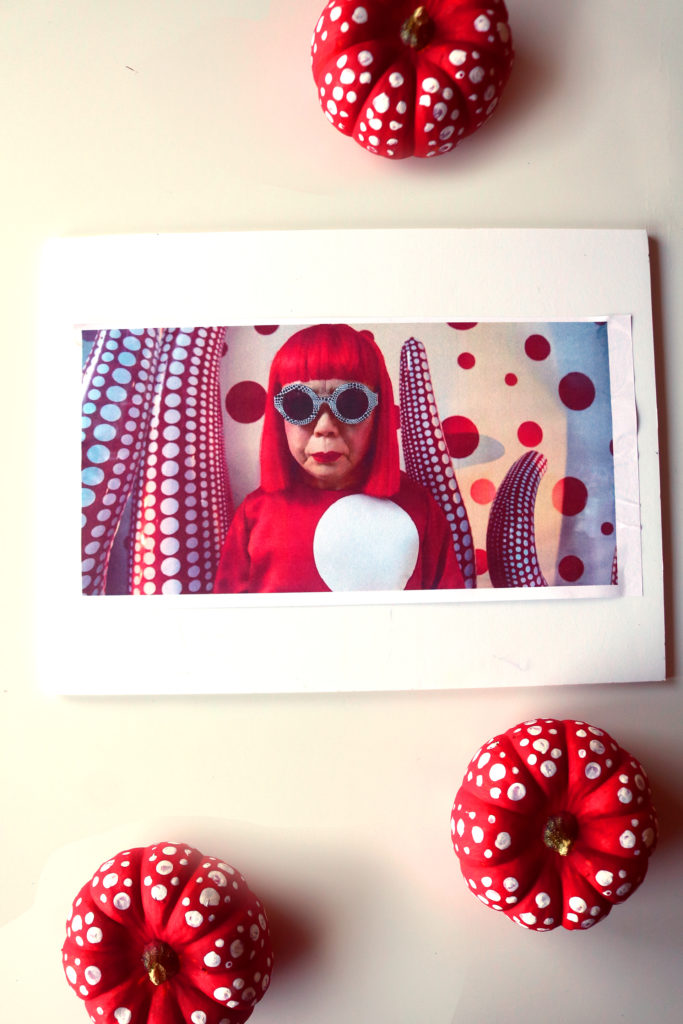Yayoi Kusama painted her world into a polka-dotted paradise and transformed the New York creative scene with her flashy pop art installations.
Bright, bold, and optically illusioned, Kusama’s work appeals to a child’s natural affinity for primary colors and clean, geometric patterns.
Add a little psychedelic swash to your art history curriculum with these Yayoi Kusama lesson ideas!
Yayoi Kusama

“With just one polka dot, nothing can be achieved. In the universe, there is the sun, the moon, the earth, and hundreds of millions of stars. All of us live in the unfathomable mystery and infinitude of the universe. Pursuing philosophy of the universe through art under such circumstances has led me to what I call stereotypical repetition.”
–Yayoi Kusama
Born in Japan, Yayoi Kusama migrated to the United States in the 1950s.
Her work drew the attention of other well-known artists in New York. Most notably, her friendship with Georgia O’Keefe blossomed into a famously fruitful one.
Yayoi Kusama’s work crosses many genres, including pop art, fashion, and sculpture.
Her style is best known for:
*Polka dots!
*Optical illusions, often created with mirrors or “twisting” lines and shapes.
*Bright colors
*Clean lines
*Geometric patterns
Focus Piece

When I teach a new artist, I find focusing on 1 or 2 pieces of art “sticks” better to my child’s memory than trying to cover a large body of work.
In this case, we took a close look at Yayoi Kusama’s polka-dotted pumpkin series.
Of her many vibrant pieces, the pumpkins seemed most relatable to children and fit nicely with the autumn season.
The Project

Inspired by Kusama’s wild imagery and her intergalactic mind, I brought a bag of mini pumpkins to my son’s homeschool co-op and placed them on the table with . . . like, every color of acrylic paint in the craft closet.
I let the kids paint their pumpkins any color they wanted but encouraged them to stick with one and paint it solid.
The pumpkins needed to dry before we painted polka dots. So, while we waited, I read them a book about Kusama’s life (see below).
But you could stretch this out over 2 classes or homeschool days.
Once the pumpkins dried, I gave the kids items to make different-sized dots. We used eraser heads from new pencils and cotton swabs. But you could use paint daubers or any circular form dipped in paint.
It looks especially cool if you encourage them to come up with their own repetitious patterns with different-sized dots.
She Covered Everything With Dots & Wasn’t Sorry!

With her recent surge in popularity, there are a number of lovely children’s books about Yayoi Kusama.
I selected (affiliate link —>) Yayoi Kusama Covered Everything With Dots and Wasn’t Sorry by Fausto Gilberti.
The Wasn’t Sorry series features unique, 2-tone color illustrations and biographies about several contemporary artists.
I liked this one because it kept the storyline simple and digestible for young minds. The author confronts difficult issues (like Kusama’s lifelong battle with mental illness) in an age-appropriate way that I felt comfortable sharing with my own child as well as the children in our co-op.

